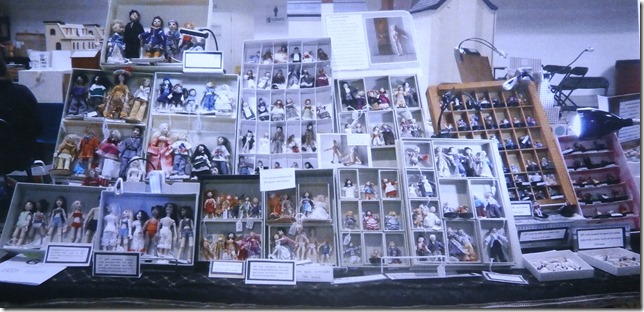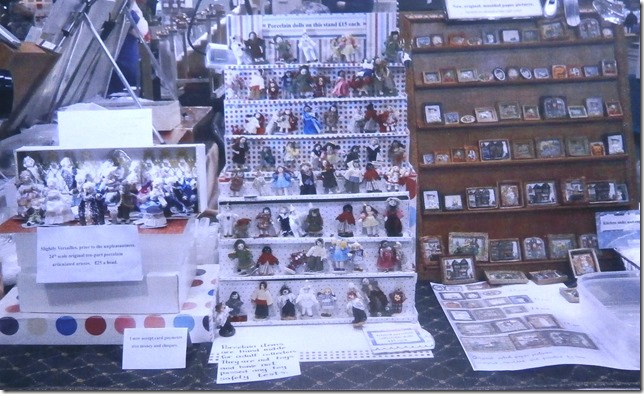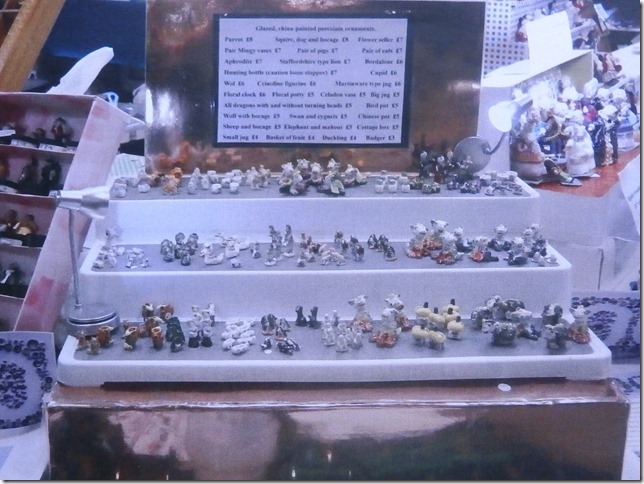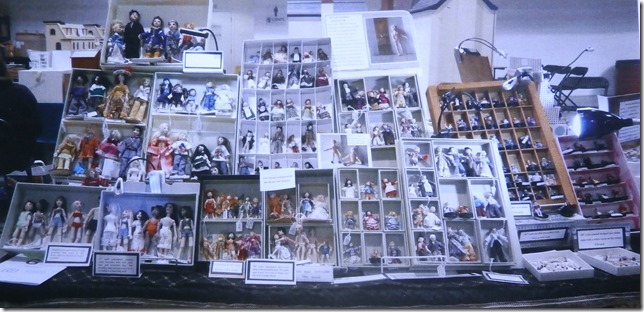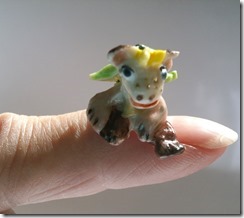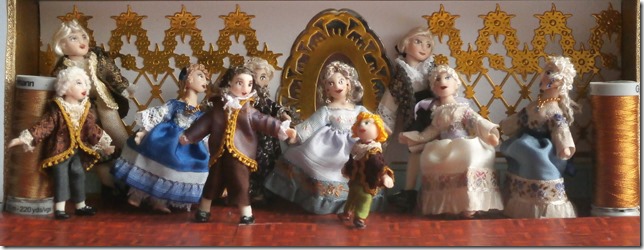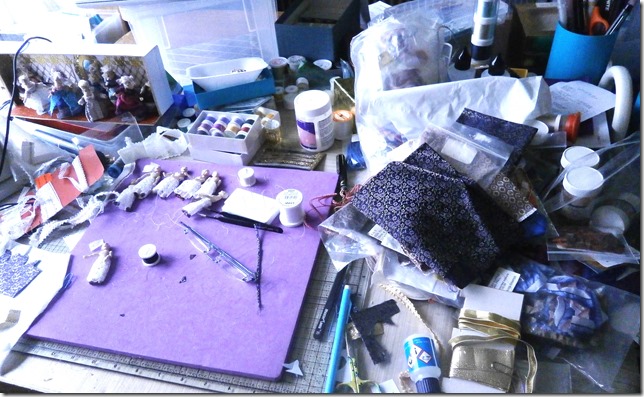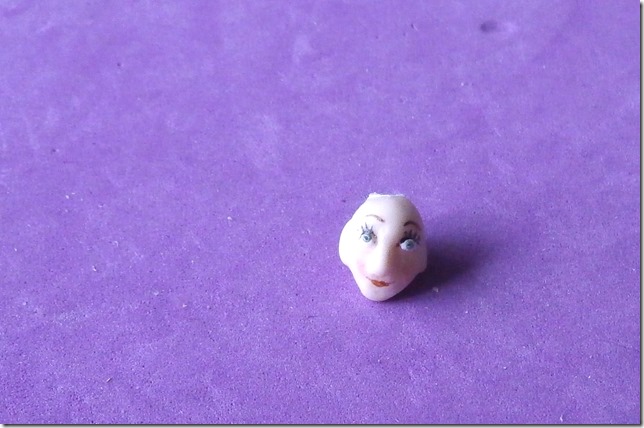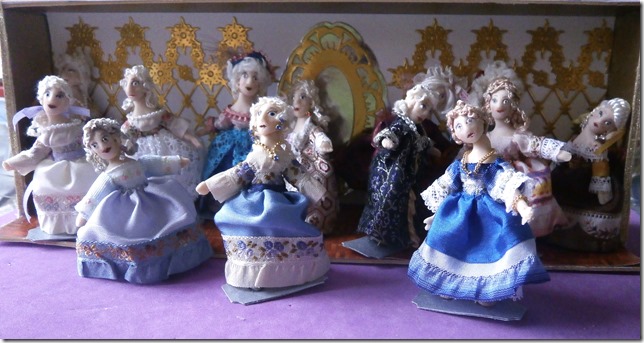Je faff. Faffez vous?
Faffing around goes hand in hand with any artistic endeavour like rain goes with football, or snacks go with TV.
I have had every intention of settling down to the next show since the last show, which was five weeks ago. I have a long list of dolls to model and things to make and a stand upgrade to get it all on to the table.
So far I’ve been shopping.
Pre-action shopping these days means hours surfing the net. I was actually shopping for something I needed. For many years I have been propping the doll boxes up on collapsible painting stands, inherited from my father. These tubular metal triangular stands, with an unfolding ledge at the bottom were not only perfect for standing paintings on for display in the shop he had for a few retirement years, they were designed for the purpose. They were not designed for a precarious tower of doll boxes held on dangerously, with blu-tack. I used to wince when I was setting them up and cross my fingers when I left them at the end of the first day, in a hall which would get cold enough overnight to stop the sticky being tacky. You can only push your luck so far, I believe.
Therefore, after a bit of Internet shopping, I have invested in two solid wooden table easels, which work in exactly the same way but have actual flat wood behind the boxes instead of fresh air, fresh air as a medium of support leaving plenty to be desired.
It’s amazing how Internet shopping A) always ends at tea time and B) is sufficiently exhausting to make you only want to surf the net after tea for recreational shopping, not that I had any money left, but it’s always nice to cast aspersions on the clothing you would scorn to wear if you lost a couple of stones in weight and it was in a clear-out sale.
That took care of the first week.
The second week was faffing around to see how the easels fitted on the boxes I made for last time, that left a space all along the table top for a line of small boxes in book stands.
All the bottom row here are boxes held in metal book stands.
Week six and I’ve got round to wondering what to do about the wooden printer’s tray.
So what happened to weeks three, four and five?
Well may you ask. Faffing is the answer. First, I reasoned that, as I was going to be very busy I needed to make a lot of cards for the spate of birthdays upcoming.
Long ago Terry Curran asked me, now I had turned my hobby, dollshousering, into my job, what I was going to do for a hobby. Card making, as it turns out. It’s quite a relief to make stuff to give away, and it’s another relief to make stuff out of bits of card. If it goes wrong, or you don’t like it you just put it in the carboard recycling. I’m actually getting quite good at it and don’t need to recycle very often these days. I have kept some of my early efforts to remind myself, being my own worst critic, that I am improving. I would recommend this ploy to anyone having a go at anything at all arty. It is completely normal to love the first one of anything you make for a good five seconds. Five glorious seconds during which you wonder what the phone number of Tate Modern might be and when is the best time to put them on alert to clear a gallery for you. Then reality sets in and the dustbin beckons. If you can avoid hurling your piece of art in, in disgust and instead put it in a drawer, under a heap of bills, if you must, you will be glad in a few years when you have reached the level of progress known as stuck. Retrieving the awful art you will see that, against your own perception, you are actually learning something, and not as stupid as you thought you were.
I have followed this plan on numerous occasions. I kept the books I wrote as a child, which are now, obviously, unintentionally hilarious. I kept the first miniature doll I made from someone else’s kit and dressed, very badly, using sewing thread the size of barge rope and giant offcuts of old dressmaking material.
I have been attending portraiture sporadically for a few years interrupted by my own ill health and freely available Covid for all. I soon began drawing on paper that would fit in a 12 inch scrapbook. I am on to my second scrapbook now and, compared to the first book, learning all the time. As soon as I think I might be getting proficient in a medium, I change medium. I am water colouring for a few weeks, currently.
However, as you know, sculpting for mould making is my real art. I love it. Because I love it I always fear that I will not be good enough. You might think after 31 years of doing it that I would be confident. Confidence, I find, needs to be summoned. In a way I am glad it is so. There are real world, full size artists who believe their arrangements of bricks, unmade beds, geometric shapes on canvas and the like, are so very good that they seem, to me at least, to be brimming with confidence.
Does anyone know where the confidence shop is located?
I have never found it.
Perhaps because I am married to someone who thinks making dolls is easy, stupid or childish. As do many others. A dolls’ house, is really just a box. Wooden furniture is not all that difficult. I have made many houses and everything in them and believe original porcelain dolls to be the most difficult items to achieve well.
At the start of what I didn’t know at the time was going to be a sort of career in doll making, potential customers were quick to tell me if I’d got something wrong. I don’t hear that type of criticism often nowadays, which makes me think that learning may have taken place.
Nevertheless, in an unregarded field of art I find it takes time to pluck up the courage to get started. Whilst summoning the urge and stiffening of the sinews is underway, I faff.
Sometimes I even sit down and write a blog instead of getting on with it.
~~~~~~~~~~~~~

